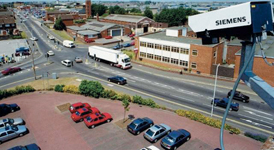
Security is one of the most basic of human needs and impacts virtually every facet of modern life. Yet ensuring the safety and security of people and the buildings in which we work and live is one of the most complex challenges governments and businesses around the world are faced with today.
Alvin Flaum, divisional director of Siemens Building Technologies Southern Africa says that government is faced with two main security challenges: how to protect and even
enhance freedom and security with the right measures; and how to ensure that security measures introduced support rather than restrict our freedom.

“In the public sector the primary objective is to assure the best possible protection while at the same time allowing maximum personal freedom,” says Flaum. “Therefore an effective prevention and protection concept to assure public security and safety must be in place. In the case of a threat, authorities are well-prepared and can respond and react effectively.”
It is a sad fact of life that wherever major retailers and businesses congregate, so too do would-be thieves. In that respect, South Africa's cities are no different to any other major city in the world, but perhaps have suffered more than others from crime, including shop theft, vandalism, car theft, cash-in-transit robberies and anti-social behaviour.
Lessons in efficient public sector security can be learnt from international city surveillance projects like the Liverpool City Watch CCTV scheme. The Liverpool CitySafe Partnership – whose members include the City Council, Merseyside Police, Liverpool City Police and Mersey Travel – run what is regarded as one of the most sophisticated CCTV turnkey surveillance systems in the United Kingdom. City Watch is the name for the operational security service that is part of the Liverpool City Council’s Community Safety Department.
“The core CCTV set-up was installed by Siemens Building Technologies Security Systems,” says Flaum. The system consists of more that 250 surveillance cameras, of which 50 are dual-purpose automatic number plate recognition (ANPR) cameras, a fibre-optic network totalling over 87 km, 12 public help points and a main control room consisting of five operator positions complete with GUI control with detailed maps of camera locations.

The main control room is protected by additional CCTV cameras located both inside and outside of the building. Access has been restricted by the introduction of a new electronic swipe card system installed at all of the entry and exit points. In addition there are four other control locations located within the emergency services headquarters across Liverpool.
The main control room is used to monitor four key areas – Liverpool Centre, North Liverpool, Kensington and South Liverpool. The project was completed in 2003 and in its first three months of operation, the CCTV scheme observed 2500 incidents and resulted in 400 prosecutions. On average between 30 and 35 arrests per week are being made on the strength of the CCTV images. The system features a fullydocumented audit trail, allowing operators to track an event as it happens. If an incident occurs that requires additional support, the control room operators can directly route live camera video via the fibre-optic network to a monitor located at police headquarters.
Cash-in-transit robberies are also down thanks to the ANPR cameras situated around the city, which can capture the license plates of getaway vehicles.
By adding CCTV to the ANPR control room operators can capture the driver’s face and those of any passengers. The CCTV scheme is proving to be beneficial in other non-crime related ways too. The Liverpool Urban Traffic Control also has limited access to the surveillance system, which assists them with the manipulation of traffic signalling to avoid traffic congestion during rush hours. Accidents are also monitored and recorded, supporting emergency services to operate efficiently and quickly.
Members of the public who require emergency assistance can call an operator in the main control room by using one of the 12 help points linked to the surveillance system. The nearest camera is automatically fixed on the individual calling, and the appropriate assistance can be provided.
Control room operators can monitor system usage at all times and override its operation if and when required. The status of each and every camera can also be monitored from the control room, allowing operators to check if cameras have been moved or vandalised.
This is one of the biggest city centre security systems installed in the UK and it has greatly improved the safety and security of citizens in Liverpool. Siemens worked very closely with Liverpool City Council and the Merseyside Police to ensure the scheme is not intrusive but offers the public peace of mind,” says Flaum.
With 2010 fast approaching and the South African government making significant investments to provide citizens and visitors with a safe and pleasant environment for the FIFA
World Cup.
For more information contact Jose Machado, Siemens Southern Africa, +27 (0) 11 652 2149, www.siemens.co.za
© Technews Publishing (Pty) Ltd. | All Rights Reserved.